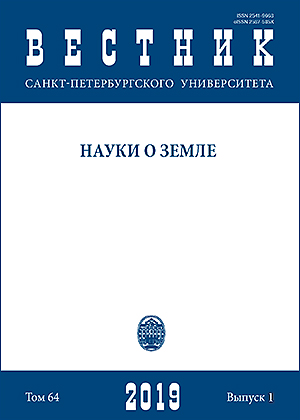Structure and depositional environment of the Valanginian-Hauterivian sections in the middle reaches of the Bodrak River (South-Western Crimea)
DOI:
https://doi.org/10.21638/spbu07.2019.107Abstract
The materials, collected during the description of 17 outcrops of Karatlykh formation (Lower Valanginian) and Karaghach formation (Lower Hauterivian) in the Bodrak River middle course (South-Western Crimea), are analyzed. The results of microscopic descriptions of thin sections, computed micro-tomography of samples, carbonate content detection, and particle-size analysis of insoluble residue are presented, the remains of scleractinian corals and cartilaginous fish are studied. Descriptions and sedimentological interpretation of 8 lithological-genetic types of layers are also presented in this article. During Karatlykh time and regressive phases of Karaghach time, terrigenous sedimentation prevailed. From the coast to the center of the basin there were pebble-sandy beaches, sandy ripples, detrital ripples with sandy depressions, detrital ripples of the far part of the shallow-water shelf. During transgressive phases of the Karaghach time, there was a shortage of terrigenous sedimentary material and carbonate sedimentation dominated. The area with solitary corals was formed along the coast and separated from the sea by patch reefs zone, detritus and coral bioherms were located on the fore reef zone. Deeper there were detrital ripples with sandy depressions, detrital rippleswith single bioherms and detrital ripples with rare biostromes. According to bed’s vertical sequences, transgressive-regressive sedimentation cycles are established. It became the basis for a detailed correlation of sections. Paleogeographic schemes for the short range of geological time corresponding to transgressive and regressive maxima are compiled. It is shown that in the paleobasin there were two types of lateral sequences of accumulative landscapes. As a result, we demonstrate that in Lower Valanginian and Lower Hauterivian the studied territory represented a shallow offshore part of the sea, washed the land southeastward. This land represented the main terrigenous provenance for the basin.
Keywords:
South-West Crimea, Valanginian, Hauterivian, layer’s lithological-genetic type, sedimentation environment, paleogeography
Downloads
References
References
Downloads
Published
How to Cite
Issue
Section
License
Articles of "Vestnik of Saint Petersburg University. Earth Sciences" are open access distributed under the terms of the License Agreement with Saint Petersburg State University, which permits to the authors unrestricted distribution and self-archiving free of charge.






